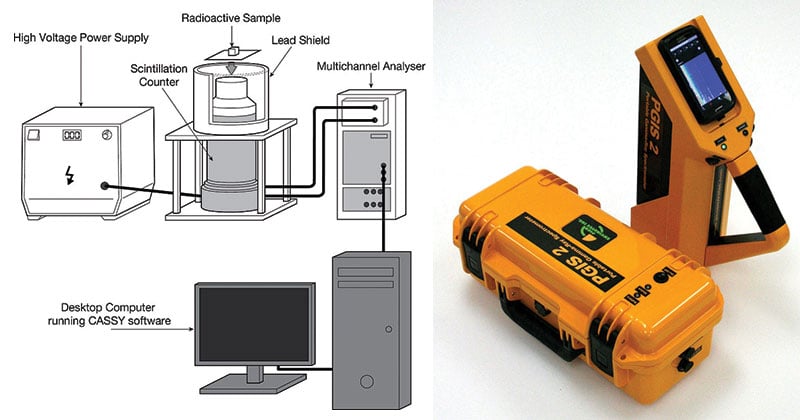Gamma rays are an ultrahigh-frequency of light that is emitted by radioactive elements, energetic celestial bodies such as black holes and neutron stars, and high energy events such as nuclear explosions and supernovae.
Interesting Science Videos
What is Gamma-ray (γ-ray) Spectroscopy?
Gamma-ray (γ-ray) spectroscopy is a quick and nondestructive analytical technique that can be used to identify various radioactive isotopes in a sample.
A gamma-ray spectrometer (GRS) is an instrument for measuring the distribution of the intensity of gamma radiation versus the energy of each photon.

Principle of Gamma-ray (γ-ray) spectroscopy
- Most radioactive sources produce gamma rays, which are of various energies and intensities.
- When these emissions are detected and analyzed with a spectroscopy system, a gamma-ray energy spectrum can be produced.
- In gamma-ray spectroscopy, the energy of incident gamma-rays is measured by a detector.
- By comparing the measured energy to the known energy of gamma-rays produced by radioisotopes, the identity of the emitter can be determined.
- A detailed analysis of this spectrum is typically used to determine the identity and quantity of gamma emitters present in a gamma source and is a vital tool in the radiometric assay.
- The gamma spectrum is characteristic of the gamma-emitting nuclides contained in the source.
Instrumentation of Gamma-ray (γ-ray) spectroscopy
The equipment used in gamma spectroscopy includes:
- An energy-sensitive radiation detector
The commonly used detectors may be any among the two:
Scintillation detector
- Scintillation is the process by which some material, be it a solid, liquid, or gas, emits light in response to incident ionizing radiation.
- In practice, this is used in the form of a single crystal of sodium iodide that is doped with a small amount of thallium, referred to as NaI(Tl).
- This crystal is coupled to a photomultiplier tube which converts the small flash of light into an electrical signal through the photoelectric effect.
- This electrical signal can then be detected by a computer.
Semiconductor detector
- A semiconductor accomplishes the same effect as a scintillation detector, conversion of gamma radiation into electrical pulses, except through a different route.
- In a semiconductor, there is a small energy gap between the valence band of electrons and the conduction band.
- When a semiconductor is hit with gamma-rays, the energy imparted by the gamma-ray is enough to promote electrons to the conduction band. T
- his change in conductivity can be detected and a signal can be generated correspondingly.
- Germanium crystals doped with lithium, Ge(Li), and high-purity germanium (HPGe) detectors are among the most common types.
- Electronics
It processes detector signals produced by the detector.
For example. A pulse sorter (i.e., multichannel analyzer)
- Associated amplifiers and data readout devices
They help in the generation, display, and storing of the spectrum.
Applications of Gamma-ray (γ-ray) spectroscopy
- They are used extensively in the studies of:
- Nuclear structure
- Nuclear transitions and
- Nuclear reactions
- In space research such as water detection on planets
- Used for the elemental and isotopic analysis of airless bodies in the solar system, especially the moon and mars.
- GRS instruments supply data on the distribution and abundance of chemical elements
References
- https://en.wikipedia.org/wiki/Gamma_spectroscopy
- https://www.physlab.org/wp-content/uploads/2016/04/GammaExp-min.pdf
- https://archive.cnx.org/contents/686b9c8b-1656-49ec-a969-84da62a60eca@1/principles-of-gamma-ray-spectroscopy-and-applications-in-nuclear-forensics
- https://owlcation.com/stem/Gamma-Ray-Spectroscopy
- https://stfc.ukri.org/files/a-bruce-gamma-spectroscopy/

I find gamma spectroscopy for luminescence dating application. Can you suggest me?
Hello,
We are looking to source a Gamma Ray/Semiconductor Detector. Can you please give us some sort of indication of costs and delivery period so we can set our budgets. We are looking for a portable unit.
Dear James,
Sorry I have no idea about this.
Thanks,